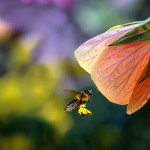Category: Science
Created by: absit.nomen
Number of Blossarys: 5
The sting of a bee has two lancelets supported by hard plates. Strong muscles are connected to poison gland surround the sting. The purpose of a sting is defense, however once a honey bee stings, it ...
The thorax is the midsection (tagma) of a bee's body. It holds the head, legs, wings and abdomen. It is also called mesosoma in other arthropods. It is formed by the prothorax, mesothorax and ...
The abdomen of a bee has seven segments and contains female reproductive organs in the queen, male reproductive organs in the drone, and the stinger in both workers and queen.
The main function of the bee's legs is movement, however bees also use their legs to manipulate and carry pollen and propolis (a resin substance from trees). The hair on the legs help dust off pollen ...
The hindwing's main function is also flight and can at times be attached to the forewings by hooks called hamuli so both pairs of wings can beat in sychrony. It is also used to fan away heat and cool ...
A Honey bee's forewing is typically larger than its hindwing. Its main function is flight but it also is used as a cooling mechanism.
Proboscis (Latin proboscis, the latinisation of the Greek προβοσκίς (proboskis), which comes from πρό (pro) "forth, forward, before"[2] + βόσκω (bosko), "to feed, to nourish")is a tube for collecting ...


 English (EN)
English (EN) 





